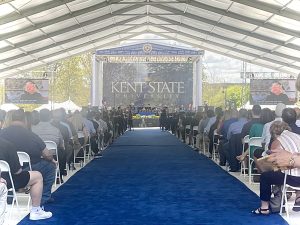New York CNN — Donald Trump brought bombastic rhetoric to the witness stand Monday in the civil fraud case against him and his business, as he spent his time on the stand attacking the New York attorney general who brought the case and the judge overseeing the trial itself.
Trump’s testimony at times mimicked his appearances on the campaign trail, where the former president has made the four criminal cases against him – along with the New York attorney general’s civil fraud case – a central part of his argument to be elected president again in 2024.
Judge Arthur Engoron, who has clashed with Trump throughout the trial, at first tried to stop the former president’s political barbs and speechifying, telling his lawyer Chris Kise to “control your client” and threatening to have Trump removed as a witness.
Eventually, the judge stropped trying to control Trump – he and the attorney general’s lawyer questioning Trump let him rant, and then mostly disregarded the missives.
The high-stakes civil case strikes at the heart of Trump’s brand – his real estate empire. New York Attorney General Letitia James is suing Trump for $250 million and seeking to bar him from doing business in the state. Engoron has already ruled Trump and his co-defendants were liable for fraud.
Here are the takeaways from Trump’s day on the stand:
The campaign comes to the courtroom
The former president’s rhetoric at times during his testimony might as well have been at one of his rallies in front of supporters. He went after the attorney general. The judge. And the “political witch hunt” that he’s been railing against for years now.
“This is a political witch hunt and I think she should be ashamed of herself,” Trump said of James.
Trump’s attacks in a vacuum weren’t particularly remarkable – he’s used the same barbs throughout the course of the trial, which he’s attended repeatedly as a spectator.
But on the witness stand, the charged rhetoric was even more remarkable, as he attacked the judge sitting right next to him, with James in the courtroom watching his testimony just feet away.
“The fraud is on the court, not on me,” Trump said.
“It’s a terrible thing you’ve done,” he said to the judge. “You believe this political hack back there and that’s unfortunate.”
Kevin Wallace, the lawyer with the attorney general’s office who questioned Trump, tried to pin down the former president. But Trump, as is his speaking style, found ways to intertwine asides and attacks into his responses even when he was answering the question.
Trump’s rhetoric prompts an angry response from the judge
Engoron tried at the outset of Trump’s testimony to stop the former president from making speeches and instead answer the questions, but it did little to change Trump’s approach.
The judge responded by threatening to remove Trump from the witness stand, though that didn’t deter the former president either.
“This is not a political rally,” Engoron said to Trump, telling Kise to “control your client.”
Kise responded by arguing to Engoron to let Trump speak. At one point, Kise called his client’s answers “brilliant.”
“The court needs to hear what he has to say about these statements,” Kise said. “He’s describing to you about why there was no intent to mislead anyone with his answers. That’s what he’s doing.”
Engoron did not agree.
“I am not here to hear what he has to say,” Engoron said, raising his voice and telling Trump attorney Alina Habba and Kise to sit down. “We are here to hear him answer questions, and most of the time he’s not.”
Before the testimony could resume, Trump weighed in. “”This is a very unfair trial. Very, very and I hope the public is watching,” he said.
After a morning break, Engoron took on a more passive role in policing Trump’s statements. He told Wallace that he was following his lead on Trump’s answers, “if you want to let the witness ramble on, nonresponsive, repeat himself.”
Of course, antagonizing the judge will only get Trump so far in the trial: The civil action is a non-jury trial, so Engoron will decide the outcome.
Trump acknowledges changing valuation of Trump Tower triplex
The attorney general’s office pressed Trump on the properties central to his identity and brand: Mar-a-Lago, Trump Tower and other key parts of his real estate empire.
Wallace pressed Trump to acknowledge the differing values in his statements of financial condition, the financial documents that have been ruled to have fraudulently inflated the former president’s net worth to obtain better loan rates. An expert for the attorney general determined the Trump Organization saved $168 million in ill-gotten gains.
Wallace pressed Trump on why valuations of properties were changed, such as his Trump Tower triplex, which was devalued on his financial statement in 2017 after a Forbes article found he had dramatically exaggerated the size of the apartment.
Trump acknowledged there had on occasion been mistakes, such as the Trump Tower apartment valuation.
The value of the apartment fell from $327 million in 2016 to roughly $116.8 million in 2017 – which came after Forbes Magazine outed Trump in 2017 for claiming the apartment was more than 30,000 square feet when it turned out to be just under 11,000 square feet. Wallace asked Trump whether he was involved in the change.
“Probably,” Trump said, before giving several possible explanations.
He acknowledged there could have “been a mistake” but said that’s why his statements included disclaimer clauses and that banks are responsible for their own due diligence.
“There’s a disclaimer clause where you don’t have to get sued by the attorney general of New York,” Trump said.
“If I wanted to build up the statement like you said I did before you found out just how rich we are, I would’ve added brand value here and I would’ve increased it by tens of millions of dollars,” Trump said at another point in the questioning.
Trump’s beautiful, expensive properties
The former president’s rhetorical flourishes went beyond attacking those who are investigating him. He also took the opportunity to play salesman and play up his properties.
One of his chief complaints about the judge is a citation in his decision that Mar-a-Lago was worth $18 million, a number based on Florida tax appraisal records.
“It’s much more valuable,” Trump said of Mar-a-Lago, “and we’ll show that in two weeks or five weeks or nine weeks or whenever this thing goes, that it’s biggest value is using it as a club.”
Wallace took the answer to pin him down on that valuation. “You believe that as of today Mar-a-Lago is worth $1.5 billion?” Wallace asked.
“I think between a billion and a billion-five,” Trump responded.
When Trump was questioned about his golf resort in Aberdeen, Scotland, the former president was less interested in explaining why there were discrepancies in the number of housing units he had intended to build on his financial statement than he was talking up his piece of land.
“I think it’s the greatest golf course ever built,” Trump said. “It’s one of the greatest pieces of land I’ve ever seen.”
This story is breaking and will be updated.















